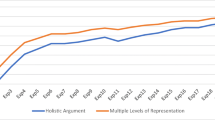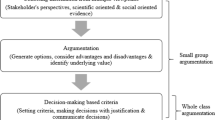Abstract
This study was designed to examine students’ use of multiple modal representations within their written arguments as a consequence of completing a series of investigations of an organic chemistry laboratory course. One hundred and eleven students from a major Midwestern university were involved in using the Science Writing Heuristic (SWH) approach where they are required to use the argument structure of question, claim, evidence and reflection in completing the written report for their instructor on their laboratory investigations. Results indicate that students who achieved a high score for embedded multiple modal representations in the evidence section also constructed high quality arguments. That is, students who were able to embed multiple modal representations in evidence made strong reasoned connections to support their claim(s) and construct a cohesive argument. Further, there were strong correlations between the laboratory examination score and holistic quality of argument. This study suggests there is a need to build support structures pedagogically for the individual in order to help students understanding the role and function of multiple modal representations in science.





Similar content being viewed by others
References
Ainsworth, S. (2006). DeFT: A conceptual framework for considering learning with multiple representations. Learning and Instruction, 16, 183–198.
Anderson, T. L., & Bodner, G. M. (2008). What can we do about ‘Parker’? A case study of a good student who didn’t ‘get’ organic chemistry. Chemistry Education Research and Practice, 9, 93–101.
Bhattacharyya, G., & Bodner, G. M. (2005). “It gets me to the product”: how students propose organic mechanisms. Journal of Chemical Education, 82, 1402–1407.
Bodner, G. M., & McMillen, T. L. B. (1986). Cognitive restructuring as an early stage in problem solving. Journal of Research in Science Teaching, 23, 727–737.
Carter, C. S., LaRussa, M. A., & Bodner, G. M. (1987). A study of two measures of spatial ability as predictors of success in different levels of general chemistry. Journal of Research in Science Teaching, 24, 645–657.
Christopherson, J. T. (1997). The growing need for visual literacy at the university. Paper presented at the Visionquest: Journeys Towards Visual Literacy. 28th Annual Conference of the International Visual Literacy Association, Cheyenne, Wyoming.
Choi, A. (2008). A study of student written argument using the Science Writing Heuristic approach in inquiry-based freshman general chemistry laboratory classes. Unpublished doctoral dissertation. University of Iowa, Iowa City, IA.
Clark, J. M., & Paivio, A. (1991). Dual coding theory and education. Educational Psychology Review, 3, 149–210.
Emig, J. (1977). Writing as a mode of learning. College Composition and Communication, 28, 122–128.
Gilbert, J. (2004). Models and modeling: routes to more authentic science education. International Journal of Science and Mathematics Education, 2, 115–130.
Gilbert, J. (2005). Visualization: A metacognitive skill in science and science education. In J. Gilbert (Ed.), Visualization in science education. Dordrecht: Springer.
Keys, C. W., Hand, B., Prain, V., & Collins, S. (1999). Using the Science Writing Heuristic as a tool for learning from laboratory investigations in secondary science. Journal of Research in Science Teaching, 36, 1065–1084.
Kozma, R. (2003). The material features of multiple representations and their cognitive and social affordances for science understanding. Learning and Instruction, 13, 205–226.
Kozma, R., & Russell, J. (1997). Multimedia and understanding: expert and novice responses to different representations of chemical phenomena. Journal of Research in Science Teaching, 43, 949–968.
Kozma, R., & Russell, J. (2005). Students becoming chemists: Developing representational competence. In J. Gilbert (Ed.), Visualization in science education (pp. 121–146). Dordrecht, The Netherlands: Springer.
Kozma, R., Chin, E., Russell, J., & Marx, N. (2000). The role of representations and tools in the chemistry laboratory and their implications for chemistry learning. Journal of the learning sciences, 9(2), 105–143.
Lemke, J. L. (1998). Multiplying meaning: Visual and verbal semiotics in scientific text. In J. R. Martin & R. Veel (Eds.), Reading science (pp. 87–112). London: Routledge.
Mayer, R. E. (1997). Multimedia learning: are we asking the right questions? Educational Psychologist, 32, 1–19.
Mayer, R. E. (2003). The promise of multimedia learning: using the same instructional design methods across different media. Learning and Instruction, 13, 125–139.
Nakhleh, M. B., & Postek, B. (2008). Learning chemistry using multiple external representations. In J. K. Gilbert, M. Reiner, & M. Nakhleh (Eds.), Visualization: Theory and practice in science education (pp. 209–231). Dordrecht: Springer.
Nakhleh, M. B., Donovan, W. J., & Parrill, A. L. (2000). Evaluation of interactive technologies for chemistry websites: educational materials for organic chemistry websites (EMOC). Journal of Computers in Mathematics and Science Teaching, 19, 355–378.
Paivio, A. (1986). Mental representations: A dual coding approach. Oxford: Oxford University Press.
Prain, V. (2009). Researching effective pedagogies for developing the literacies of science: Some theoretical and practical considerations. In M. Shelley, L. Yore, & B. Hand (Eds.), Quality research in literacy and science education: International perspectives and gold standards (pp. 150–168). Dordrecht: Springer.
Roth, W. M., & McGinn, M. K. (1998). Inscription: toward a theory of representing as a social practice. Review of Educational Research, 68, 35–59.
Sandoval, W. A., & Millwood, K. A. (2005). The quality of students’ use of evidence in written scientific explanation. Cognition and Instruction, 23, 23–55.
Schnotz, W., & Bannert, M. (2003). Construction and interference in learning from multiple representation. Learning and Instruction, 13, 141–156.
Shrout, P. E., & Fleiss, J. L. (1979). Intraclass correlations: use in assessing rater reliability. Psychological Bulletin, 86, 420–428.
Staver, J. R., & Jacks, T. (1988). The influence of cognitive reasoning level, cognitive restructuring ability, disembedding ability, working memory capacity, and prior knowledge on students’ performance on balancing equations by inspection. Journal of Research in Science Teaching, 25, 763–775.
Wu, H., & Shah, P. (2004). Exploring visuospatial thinking in chemistry learning. Science Education, 88(3), 465–492.
Author information
Authors and Affiliations
Corresponding author
Rights and permissions
About this article
Cite this article
Hand, B., Choi, A. Examining the Impact of Student Use of Multiple Modal Representations in Constructing Arguments in Organic Chemistry Laboratory Classes. Res Sci Educ 40, 29–44 (2010). https://doi.org/10.1007/s11165-009-9155-8
Published:
Issue Date:
DOI: https://doi.org/10.1007/s11165-009-9155-8




